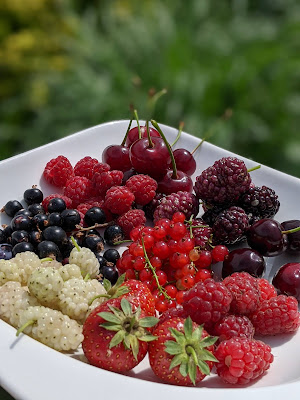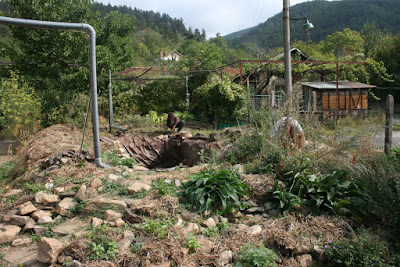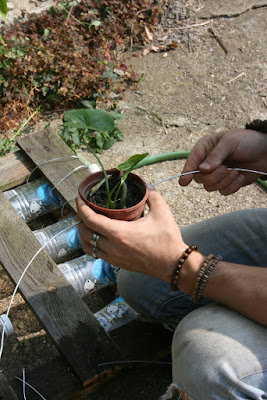Such a great time of year in the gardens, with delicious fruit dripping off the trees and shrubs, flowers blooming within the support vegetation and the invertebrate life in the gardens is peaking with the air and flowers full of beneficial insects.
Here's what we've been up to in the gardens this week.
Two years back we grew an unusual cultivar of Tomato, called 'Raisin'. As the name suggests, the fruits are pretty small, slightly bigger than a raisin, although not by much. This was not an ideal cultivar to be growing when you're looking to measure the weight of the harvest per kilogram, but the plant ended up being well-liked for a number of reasons. Firstly, the plants tend to be much bushier in nature than other tomato cultivars and actually less maintenance. We gave up pinching out the axilla growth on these plants because they were so naturally keen to bush out anyway, and it became quite hard to tell which part of the plant needed pinching out.
Bushy habit of Tomato 'Raisin' - Solanum lycopersicum
Secondly, the fruit is quite delicious and a sweet treat when you're tending to the vegetable garden, plus it makes an interesting novelty item to a salad bowl. Lastly, it self seeded and appeared the following year and requiring next to no inputs, produced decent fruit again.
Raisin Tomato, on the left ripening this year and on the right, a crop from a self-seeded plant in 2019
Multi Grafts - Eddie and Hilary owners of Windfall Nursery are taking our online course this year. Eddie has been grafting fruit trees for some 20 years, and he shared with us a multi-cultivar apple he has grafted this season. A Crab Apple is the leading the stem and rootstock, and apple cultivar 'Spartan' has been grafted onto the bottom branches, while 'Cox' has been grafted onto the top branches. Eddie recommends grafting varieties that grow at the same pace to avoid the tree growing in a lop-sided manner. Such trees would be ideal for a family or one household who may enjoy different cultivars of apple from a single, self fertile tree. Eddie and Hilary have an excellent range of walnuts, fruit trees and ornamental trees on offer so do take a look at their excellent range.
Crab apple stem with cultivars 'Spartan' and 'Cox' grafted onto the lower branches
Levisticum officinale - Lovage is one of those herbs that I would say isn't so commonly used in the UK. I certainly hadn't used it in the kitchen before coming to Bulgaria. Then I had the pleasure of eating a dish prepared at the Black Sea, where Lovage was used to flavor a steaming bowl of mussels. It was a surprising combination to me, but it did work very well. Now I use it to flavor stews and bean-based dishes, although it's worth remembering that a little goes a long way in the kitchen. The plant seems equally popular in the garden. It is one of the first perennial herbs to be harvestable in the spring and can grow at a quick rate, I have observed to as high as 1.5m tall in our gardens. Lovage makes a great companion plant and is noted for attracting wildlife. As is to be expected, most insect activity occurs on a sunny day, when the flowers are in bloom.
Lovage - Levisticum officinale flowers on a wet day
One of the insect groups that are attracted to the Lovage flower is the Ichneumon wasps, which parasitize the larvae of herbivorous insects. They play an important but somewhat grisly role as a pest predator. Female Ichneumonid wasps will lay their eggs inside the host pest. After the egg hatches, the larvae feed either externally on the host or burrow into its body. Once fully fed, the larvae will pupate and emerge as an adult. You can find these insects feeding on the nectar of flowers, shrubs, and trees. Ichneumonid wasps prefer plants of Apiaceae (carrot family). They are significant in the natural control of plant pests and are often used by indoor commercial growers for pest control.
Ichneumnonidae, a parasitic wasp on Euphorbia cyparissias - Cypress spurge - Photo by Peter Alfrey
This week on our Regenerative Landscape Design Online Interactive Course we're learning about these kinds of pest predators for natural gardens. Having a basic understanding of the wild organisms that inhabit our landscapes is probably the key to success in providing food and other resources while enhancing biodiversity. There are plenty of interesting topics in the upcoming schedule, so if you are interested in joining us, you can find out more here. You'll get lifetime access to the material, so you can learn at your own pace.
We continue to be in awe of the sheer quantity and quality of fruits coming from the garden this week. It really is the simple things in life that bring the most pleasure :) Opening the door in the morning, and being able to walk into the garden and pick your own breakfast is something I'll never take for granted. All the fruits 'modelled' below are from the garden and you can find out more about them and how to grow them in the plant profiles below. We will have all these fruit trees and shrubs available from our nursery this autumn, including some really tasty cultivars of Blueberry that have good disease resistance. You can see our selection of plants here and cultivars available here. We offer recorded delivery across Europe and with limited stock, we are taking orders now for autumn delivery.
Ribes nigrum cv.- Blackcurrant, Ribes rubrum cv. - Red currant , Morus alba - White Mulberry , Rubus × loganobaccus - Loganberry, Rubus idaeus cv. - Raspberry, Prunus cerasus - Sour Cherry, Fragaria x ananassa - Strawberry
Siberian Pea Tree, Caragana arborecens is one of our favourite trees in the garden This tree has high ornamental value as well as bringing so many other benefits to a garden or landscape. There are too many to describe in a brief paragraph, so read on for an overview of this sun loving, versatile plant.
Plant Profile: Caragana arborescens - Siberian Pea Tree
Overview: A deciduous shrub originating from Central Asia belonging to the Fabaceae (legume) family growing to 5-6m high and 4m wide with an upright habit. It grows vigorously. Flowers are borne from buds on the previous year's wood and are typical of flowers from this family. Flowering occurs in May. Pollination is via bees, usually wild bumble bees Many bee species are attracted to the flowers. Pods develop from flowers - looking like small pea pods, they are 4-5 cm long. The pods ripen to amber or brown from June -July onwards and seeds fall by August. The plant is extremely hardy tolerating winter temperatures of -40, USDA Hardiness zone 2 - 7. Prefers a continental climate with hot dry summers and cold winters.
Uses: The young pods are eaten as a vegetable, lightly cooked. The pods become tough later in the season. The seeds are rich in fats and proteins (12% and 36% respectively) about the size of lentils and can be cooked and used in any way that beans are used (the cooked flavour is somewhat bland, so best used in spicy dishes). The young raw seeds have a pea-like flavour although it is not clear whether they should be eaten raw in much quantity.
The plant is widely used in windbreaks and shelter belts and used in wildlife-erosion control plantings stabilizing soil with an extensive root system. Good wildlife fodder and can be used to as poultry food. A fiber is obtained from the bark and used for rope making.
Nitrogen Fixing Potential: The species is classified by USDA as being a MEDIUM Nitrogen fixer with estimated yields of 85-160lbs/acre or 39-72kg/4050m² or 0.014g /m2
Biodiversity - The shrubs will begin to flower in the 4th or 5th year after planting and are attractive to a wide range of pollen and nectar feeding invertebrates from April - May.
In time as the hedge thickens up with regular pruning, suitable nesting habitat will form inside the lower part of the hedge. Birds such as Wren - Troglodytes troglodytes, Chiffchaff - Phylloscopus collybita and Robin - Erithacus rubecula are commonly found in dense low hedging. These birds can help to keep common vegetable pest populations low.
Welcome to our Online Store where you can find Forest Garden/ Permaculture plants, seeds, bulbs and Polyculture multi-packs along with digital goods and services such as Online Courses, Webinars, eBooks, and Online Consultancy. We hope you enjoy the store and find something you like :) It's your purchases that keep our Project going. Yuu can also find our full list of trees. shrubs and herbs for forest gardens on our website here
Propagation: Seed propagation is the norm. Seeds germinate better after a short period of stratification and/or soaking in warm water prior to planting.
Caragana arborescens seed pods
Planting Material – 5 year old plants will provide an instant hedge effect but can prove to be expensive when planting out large areas. 2nd - 3rd year whips are cost effective and with proper pruning and some attention during the first few years of development will quickly fill out.
These plants are easy to grow from seed. The first 2 years of growth are slow and they are best kept in nursery beds until approx 30 - 50 cm tall when they can be planted out into their permanent positions.
We supply seeds and 2-3 year Caragana arborecens plants from our plant nursery. Click here for more info.
You may remember a few weeks back we introduced a new annual polyculture we have been trying out this year, inspired by the developing Garlic plants. It's a successional design, so as one crop comes out, another goes in. This week we harvested the Garlic, tying it into bunches of 10 - 15 bulbs ready for hanging. creating space for the next plants.


Sophie harvesting Garlic Getting ready to be hung up to dry
Removing the Garlic was great news for the Carrots and Cabbage, which are now beginning to develop well and could use the extra space and light. On the north side there was space available from where the Garlic was harvested, because the Dill has gone to seed and finished now. We weeded this area, created another strip, and have sown some beetroot seeds.
Beautiful leaves of Albizia julibrissin - Silk tree
Carpenter Bee feeding on Spartium junceum - Broom
Regenerative Landscape Design - Online Interactive Course
Want to learn how to design, build and manage regenerative landscapes? Join us for our Regenerative Landscape Design - Online Interactive Course from May 1st to Sep 13th, 2023.
We're super excited about running the course and look forward to providing you with the confidence, inspiration, and opportunity to design, build and manage regenerative landscapes, gardens, and farms that produce food and other resources for humans while enhancing biodiversity.
Regenerative Landscape Design Online Course
You can find out all about the course here and right now we have a 20% discount on the full enrollment fees. Just use the promo code RLD2023 in the section of the registration form to receive your discount.
We are looking forward to providing you with this unique online learning experience - as far as we know, the very first of its kind. If you are thinking of reasons why you should do this course and whether this course is suitable for you, take a look here where we lay it all out. Looking forward to it!
--------------------------------------------------------------------------------------------------------------------------
Support Our Project
If you appreciate the work we are doing you can show your support in several ways.
- Make a purchase of plants or seeds from our Bionursery or Online Store
- Consider joining us for one of our Courses or Online Courses
- Comment, like, and share our content on social media.
- Donate directly via PayPal to balkanecologyproject@gmail.com or via FTX Pay
If you appreciate the work we are doing you can show your support in several ways.
- Make a purchase of plants or seeds from our Bionursery or Online Store
- Consider joining us for one of our Courses or Online Courses
- Comment, like, and share our content on social media.
- Donate directly via PayPal to balkanecologyproject@gmail.com or via FTX Pay
 |
| You can also register for our online training, services, and products directly here. |















































